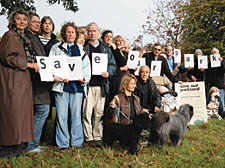|
|
 |
| |

Save Our Park protesters out in force to stop the Regent’s Park plans last month |
The character and future of Regent’s Park is now at risk
Plans to redevelop a significant part of Regent’s Park are neither necessary nor justified, says Richard Simpson
REGENT’S Park is designated as Metropolitan Open Land, and as such should not be developed.
The sports proposals are neither necessary nor justified. The advisory committee is concerned that a justification for development based on the existence of the former Holford House, bombed during the Second World War, should not be accepted. This could set a dangerous precedent for further development in the park.
The advisory committee was very concerned about the larger impact of the development – its intense lighting, traffic generation, artificial materials – on broader ecological objectives. The development would have a negative effect on the environment at a time when global warming makes sustainability essential. This is not a sustainable development.
We also question the validity of the claim that the facility was justified by it potential use by local schools.
We are aware, from statistics provided by the Royal Parks Agency and information from local schools, that the existing sports facilities are not used by local state schools who have neither the staff nor the resources to use even free facilities remote from the schools.
The provision of such facilities is not a substitute for sports facilities attached to the schools themselves. Such use cannot be a justification for the development.
It is also clear from the details of the application – café, bar, liquor licence, opening late in the evening – that the target users are not, as claimed, children but adults. How suitable the proposals are for safe use by children is in question.
The proposals would do serious harm to the character and appearance of the Regent’s Park Conservation Area.
The plans would turn this area into several acres of sterile development, culling 68 trees – more than 30 per cent of the 170 trees on the site. This is a devastating destruction in the park.
It is spurious to argue that only fine trees should be retained: it is key to the character of the area that it includes a variety of trees, many self-seeded, and not just the selected specimen trees characteristic of the more formal areas of parkland.
It would destroy the natural landscape which is a key element of the character of the conservation area by introducing a substantial bulk of fencing and netting some eight metres high, with 20 lamp standards of the same height.
The lighting, which would be used until 10.30pm, would, however directional, reflect off the plastic ‘grass’ to emphasise the bulk of the development and its alien character in the landscape. The proposed building would add to the sense of a bulky development within the parkland.
The current structures of the golf and tennis school are low-key, modest in scale and impact on the landscape, and provide no precedent for the scale and bulk of the present proposal.
The area constitutes one of the ‘gateways’ into the park: the visual character as seen from various approaches to the park (over Macclesfield bridge and round the Outer Circle, on the boundary between the Borough of Camden and the City of Westminster) would be spoilt; the visual impact of the development would be substantial and negative, harming the wider conservation area.
The plans would also devastate a rich natural habitat with considerable biodiversity, which has evolved naturally over the 60 or so years since Holford House was demolished.
The advisory committee view with incredulity the applicants’ claim that there would be no increased traffic resulting from their proposals.
Given the very limited public transport available in the immediate vicinity – the 274 bus – it is hard to believe that the core users of the five-a-side pitches, perhaps 90 at a time, arriving and leaving up to 10.30pm, will not travel by car, considerably increasing noise and other pollution in this area of natural habitat, and contradicting wider policy for reducing traffic movement.
The proposals would do serious harm to the character and appearance of the Regent’s Park Conservation Area and the committee objects extremely strongly to the application.
|
 |
|
|
 |
|
 |
|